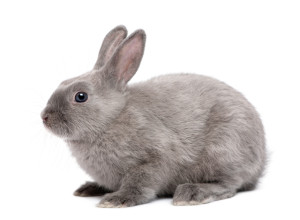A virus that affects ONLY rabbits has led the Pet Care Trust to make the unanimous decision to postpone suggesting rabbits in the classroom for the 2022-2023 school year. We will continue to support our past grant recipients that own rabbits through our sustaining grant, but will not be issuing grants to help with the purchase of rabbits at this time. To learn more, please see our blog post here: https://petsintheclassroom.org/rabbit-hemorrhagic-disease-guidance-from-pets-in-the-classroom-program/
Classroom pets are an important way to forge healthy child-pet relationships, and it’s important for teachers to educate themselves on which type of pet is best for their classroom. One popular choice of classroom pet is the domestic rabbit, which can make a wonderful pet, but also has some special requirements.
 What many people don’t realize is that rabbits are crepuscular, meaning they are primarily active during dawn and dusk hours. This means that your classroom rabbit will probably be at its most active before and after school hours. It’s important that students recognize the rabbit’s need for sleep during the day, and this should be taken into account when planning for a classroom rabbit’s weekend and vacation care as well.
What many people don’t realize is that rabbits are crepuscular, meaning they are primarily active during dawn and dusk hours. This means that your classroom rabbit will probably be at its most active before and after school hours. It’s important that students recognize the rabbit’s need for sleep during the day, and this should be taken into account when planning for a classroom rabbit’s weekend and vacation care as well.
Rabbits can be sensitive to diet changes, so it’s very important to keep your classroom rabbit on a consistent diet, and provide the proper food for out-of-classroom stays. According to the House Rabbit Society (http://rabbit.org) the proper diet for a house rabbit is “good quality pellets, fresh hay (alfalfa, timothy or oat), water and fresh vegetables.” They also point out that, “Anything beyond that is a ‘treat’ and should be given in limited quantities.”
Rabbits can also be litter-box trained. This is more easily accomplished with older, spayed or neutered bunnies, and a variety of fillings can be used in the box. Absorbent newspaper covered with hay can be used, or you can look for organic litters made from alfalfa, oat, citrus or paper. Litter-box training your classroom rabbit can allow for more freedom and exercise for the pet.
You should also create a play area for the rabbit. Rabbits need an exercise area – they need as much as 2-3 hours to stretch and play. Building an exercise area makes for a great classroom project. The area should be completely “rabbit-proofed” and contain the litter-box and a variety of bunny-safe toys. Use positive reinforcement like small bits of healthy foods to train your rabbit to return to his or her cage after play time.
According to the Minnesota Companion Rabbit Society (http://www.mn.companionrabbit.org) rabbits can be trained to walk on a leash with the proper harness. The Society even offers classes on leash-training rabbits! Look for an “H” shaped harness in the cat section of your pet supply store, or a comfort harness from the rabbit section. This training will take time and patience, and of course, all student/rabbit interactions should be carefully supervised. There may be some rabbits who decide that walking on a leash is not for them, but many enjoy the activity and interaction.
There are many rabbit education and rescue organizations throughout the U.S. that can provide teachers with valuable resources on this popular pet. Educating the entire classroom on rabbits before making the decision on a classroom pet can be a great way for children to learn more about the responsibilities of proper animal care, and the potential rewards of interacting with pets through consistent care and training.
Pets in the Classroom allows children to benefit from the social support of pets and learn to bond with and care for pets responsibly. The Pet Care Trust understands that many teachers have limited financial resources to include pet care as part of the classroom experience, so this program provides easy to apply for, direct grants that allow teachers to purchase new pets, pet environments or pet food and supplies for existing classroom pets. Visit www.dbf9eaf4ed.nxcli.io to apply for your grant today!




